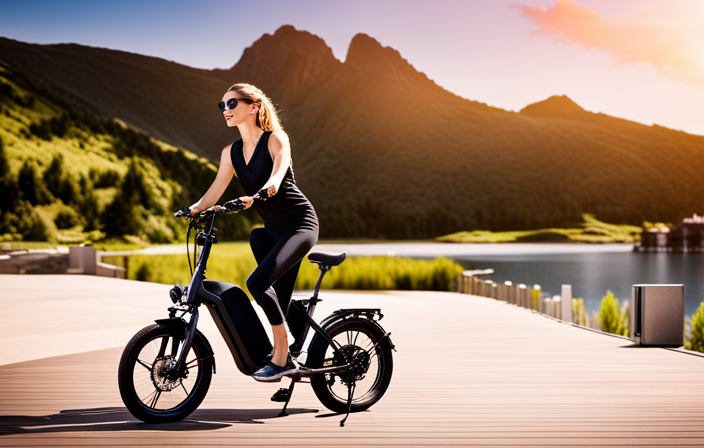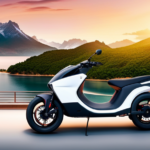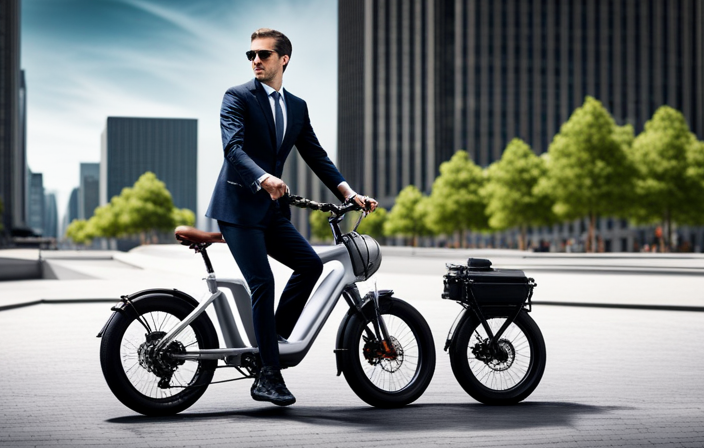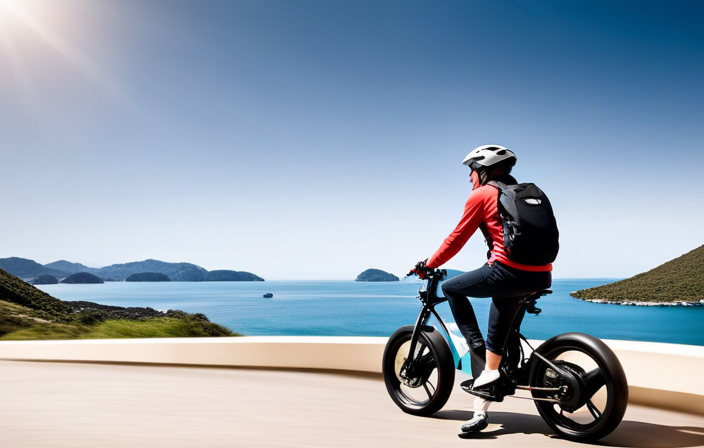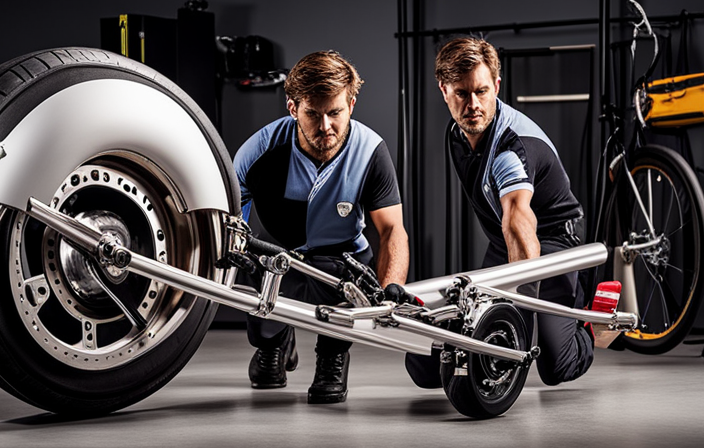Coincidentally, as I set out on my electric bike adventure, I found myself pondering the question that many riders ask: how many miles can I go on an electric bike?
In this article, we will dive into the intricacies of electric bike range, exploring the factors that affect it, such as motor type and battery capacity.
We will also discuss the future developments in electric bike range and the environmental benefits of these eco-friendly rides.
Get ready to embark on a journey of knowledge and discover just how far an electric bike can take you.
Key Takeaways
- The range of an electric bike is affected by factors such as terrain, rider weight, level of pedal assist, and wind resistance.
- The type of electric bike motor also plays a role in determining range, with hub motors, mid-drive motors, and friction drive motors being the main options.
- Battery technology and capacity are important factors, with advancements in battery technology and larger capacity batteries allowing for longer ranges.
- To maximize electric bike range, starting with a fully charged battery, maintaining a steady pace, utilizing pedal assist, and choosing lower power modes on flat terrain are recommended.
Understanding Electric Bike Range
You can go a certain number of miles on an electric bike depending on various factors.
When it comes to electric bike range comparison, the most important factor is understanding battery life.
The range of an electric bike is determined by its battery capacity, which is measured in watt-hours (Wh). Generally, the higher the watt-hour rating, the longer the range.
Other factors that affect electric bike range include the level of pedal assist, terrain, rider weight, and wind resistance.
Riding on flat terrain with minimal wind resistance and using a low level of pedal assist will maximize your range.
On the other hand, riding uphill or against strong headwinds with a high level of pedal assist will decrease your range.
Understanding these factors will help you determine how many miles you can go on your electric bike.
Factors that Affect Electric Bike Range
When considering factors that affect an e-bike’s range, it’s important to take into account various elements. Understanding range limitations is crucial in determining how far you can go on an electric bike.
One of the key factors that impacts range is the terrain you ride on. Riding on flat terrain requires less effort from the motor, allowing for longer distances to be covered. On the other hand, uphill climbs or rough terrains can significantly reduce the range as the motor has to work harder.
Additionally, the weight of the rider and any cargo being carried can also affect the range. The overall efficiency of the battery and motor system is another factor to consider.
With these factors in mind, it becomes clear that there are several variables that can impact an electric bike’s range.
Transitioning into the subsequent section about ‘types of electric bike motors’, it’s important to understand how different motors can also affect range.
Types of Electric Bike Motors
To understand the types of electric bike motors, it’s important to know that there are different options available to suit various riding preferences. Electric bike motors can be categorized based on their motor power and performance. There are three main types of electric bike motors: hub motors, mid-drive motors, and friction drive motors.
Hub motors are the most common type and are located in the center of either the front or rear wheel. They provide a smooth and quiet ride, but can limit the bike’s handling and performance. Mid-drive motors, on the other hand, are located near the bike’s pedals and provide a more balanced and efficient ride. They are known for their excellent hill-climbing capabilities. Lastly, friction drive motors are attached to the side of the bike’s tire and provide a simple and lightweight option.
Here is a table comparing the different types of electric bike motors:
| Type of Motor | Location | Pros | Cons |
|---|---|---|---|
| Hub Motor | Center of wheel | Smooth and quiet ride | Limited handling and performance |
| Mid-drive Motor | Near pedals | Balanced and efficient ride, excellent hill-climbing | More expensive |
| Friction Drive Motor | Side of tire | Simple and lightweight | Less efficient, reduced tire grip |
Next, we will delve into the fascinating world of battery technology and capacity, which plays a crucial role in determining the range of an electric bike.
Battery Technology and Capacity
Battery technology and capacity are key factors in determining how far an e-bike can travel on a single charge. With advancements in battery technology, e-bikes now have access to more efficient and powerful batteries. These new batteries can store larger amounts of energy, allowing riders to go further distances without needing to recharge.
Additionally, lightweight batteries have a significant impact on the range of an electric bike. The lighter the battery, the less energy is required to propel the bike, resulting in extended range.
When considering battery capacity, it’s important to note that the range can vary depending on factors such as terrain, speed, and rider weight. By optimizing battery technology and reducing the weight of batteries, manufacturers are constantly striving to increase the range of electric bikes.
In the next section, we will explore the different control options available for e-bikes, including pedal assist and throttle control.
Pedal Assist vs. Throttle Control
Pedal assist and throttle control are two different options available for controlling an e-bike. When it comes to electric bike performance, the power mode you choose can have a significant impact.
Pedal assist, also known as pedelec, allows the rider to pedal while the motor provides additional assistance. This mode is great for those who still want to get some exercise while riding, as the motor only kicks in when you start pedaling.
On the other hand, throttle control allows the rider to simply twist a throttle and have the motor provide power without any pedaling required. This mode is more convenient for those who want a more relaxed ride or need assistance in hilly terrains.
The comparison of power modes ultimately depends on personal preference and the type of terrain you’ll be riding on.
Transitioning into the subsequent section about tips for maximizing electric bike range, it’s important to understand the different power modes and how they can affect your overall mileage.
Tips for Maximizing Electric Bike Range
One way to extend your e-bike’s range is by adjusting your riding style and using the available power modes strategically.
Maximizing battery life and achieving the maximum distance on your electric bike requires efficient riding techniques. Firstly, make sure to start with a fully charged battery to optimize your range.
Additionally, try to maintain a steady and consistent pace, avoiding sudden acceleration and hard braking. Utilizing the pedal assist feature rather than relying solely on the throttle control can greatly increase your e-bike’s range. Pedaling along with the motor assistance helps to distribute the workload and conserve battery power.
Another tip is to choose a lower power mode when riding on flat terrain or downhill, saving the higher power levels for uphill climbs.
By following these techniques, you can maximize your electric bike’s range and enjoy a longer ride without range anxiety.
Range Anxiety and Overcoming it
Don’t let range anxiety hold you back from enjoying your electric bike to its fullest potential. Range anxiety, the fear of running out of battery power before reaching your destination, is a common concern among electric bike riders. However, with proper planning and understanding, you can overcome this fear and fully embrace the benefits of electric bikes.
To help you manage range anxiety, I have prepared a table below that outlines some key factors affecting electric bike range:
| Factor | Impact on Range |
|---|---|
| Battery Capacity | Higher capacity = longer range |
| Terrain | Hilly terrains reduce range |
| Rider Weight | Heavier riders decrease range |
| Assist Level | Higher assist levels decrease range |
By being aware of these factors and making adjustments accordingly, you can confidently ride your electric bike without worrying about running out of power. In the next section, we will explore real-life examples of electric bike ranges and how they can vary based on different variables.
Real-life Examples of Electric Bike Ranges
To better understand the range of electric bikes in real-life scenarios, let’s take a look at some examples. Here are three electric bikes that showcase their impressive range capabilities:
-
The Bosch Performance Line e-bike can travel up to 100 miles on a single charge, making it a perfect choice for commuters or those who enjoy longer rides.
-
The Specialized Turbo Vado SL has a range of up to 80 miles, thanks to its lightweight design and efficient motor system. This bike provides a smooth and comfortable ride for urban environments.
-
The Rad Power Bikes RadRover can cover up to 45 miles in challenging terrains, such as hills or off-road trails. Its powerful motor and durable construction make it an ideal choice for adventurous riders.
When comparing electric bike range to traditional bike range, it’s clear that electric bikes offer a significant advantage. With their electric assistance, riders can cover much greater distances without exerting as much physical effort.
Transitioning into the next section about long-distance electric bike tours, it’s important to consider the range capabilities of these bikes for extended adventures.
Long-distance Electric Bike Tours
Explore the possibilities of embarking on long-distance tours with your electric bicycle. Electric bikes have come a long way in terms of range, making them a great option for extended journeys.
When it comes to mountain biking, the electric bike range can vary depending on the terrain and the level of assistance you choose. On average, you can expect a range of around 30-50 miles for off-road adventures.
For commuting purposes, electric bikes offer even greater range. With advancements in battery technology, some models can go up to 100 miles on a single charge, perfect for those who travel long distances to work or school.
These long-distance electric bike tours not only provide an eco-friendly and cost-effective transportation option but also allow you to explore new places and enjoy the journey.
As you plan your adventure, it’s important to consider charging options for electric bikes, ensuring you have the power you need to keep exploring without interruption. [transition to the subsequent section about ‘charging options for electric bikes’]
Charging Options for Electric Bikes
When it comes to charging my electric bike, I have two main options: charging at home and using public charging stations.
Charging at home is the most convenient option for me, as I can simply plug my bike into a standard electrical outlet and let it charge overnight.
However, when I’m on the go or need a quick charge, public charging stations are a great option. These stations are usually equipped with fast chargers that can replenish my bike’s battery in a short amount of time, allowing me to continue my journey without any long delays.
Charging at Home
Charging an electric bike at home allows you to conveniently extend the number of miles you can go. With the right setup, you can easily charge your electric bike overnight and wake up to a fully charged battery, ready for your next adventure. The charging time will depend on the battery capacity and the charging speed of your charger.
It is important to consider the cost analysis as well. Charging your electric bike at home is generally more cost-effective compared to charging at public stations, as you can take advantage of lower electricity rates during off-peak hours. However, it is crucial to note that electricity costs may vary depending on your location and the specific charging equipment you use.
Transitioning to public charging stations provides another option for extending your ride without the need for home charging facilities.
Public Charging Stations
Public charging stations offer a convenient solution for extending your ride without the need for home charging facilities. These stations are part of a growing public charging infrastructure, which is crucial for the widespread adoption of electric bikes. The charging network expansion is aimed at providing riders with more options and peace of mind when it comes to recharging their electric bikes on the go.
To visualize the availability of public charging stations, here is a table showcasing the number of stations in three major cities:
| City | Number of Stations |
|---|---|
| New York | 50 |
| San Francisco | 30 |
| London | 40 |
As you can see, these cities have a significant number of public charging stations, making it easier for riders to find a charging point when needed. This infrastructure growth is crucial for longer rides and ensures that riders can confidently explore new areas without worrying about running out of battery power.
With the availability of public charging stations, riders can now consider other options to further extend their electric bike range, such as electric bike range extenders.
Electric Bike Range Extenders
An electric bike range extender can significantly increase the mileage you can travel. By attaching a range extender to your electric bike, you can go even farther without worrying about running out of battery power.
The benefits of using electric bike range extenders are numerous:
-
Increased range: With a range extender, you can easily double or even triple the distance you can travel on your electric bike.
-
Peace of mind: No more anxiously watching your battery level and wondering if you’ll make it to your destination. A range extender gives you the assurance that you’ll have enough power to get where you need to go.
-
Flexibility: With the option to add a range extender, you have the freedom to go on longer rides and explore new routes without limitations.
Looking to the future, there are exciting developments in electric bike range that promise even greater mileage and efficiency.
Future Developments in Electric Bike Range
Imagine how much farther you’ll be able to travel on your e-bike with the exciting future developments in range technology. Electric bike range advancements are continuously pushing the boundaries of what was once thought possible. One of the most significant areas of innovation lies in battery technologies. Manufacturers are investing in research and development to create more powerful and efficient batteries that can store higher energy densities.
These innovative battery technologies will allow e-bikes to have increased range capabilities, meaning you can go even further without worrying about running out of power. With these advancements, you can confidently plan longer rides and explore new territories. The future of electric bike range looks promising, and it’s only a matter of time before we witness even more remarkable breakthroughs in this field.
As we delve into the subsequent section about the environmental benefits of electric bikes, it becomes evident how these advancements contribute to a greener and more sustainable transportation solution.
Environmental Benefits of Electric Bikes
With advancements in battery technology, e-bikes are becoming a more environmentally-friendly transportation option. Electric bikes have made significant progress in terms of range, allowing riders to travel longer distances without the need for recharging. This increased range not only benefits riders but also has a positive impact on greenhouse gas emissions.
By choosing an electric bike over a traditional vehicle, individuals can reduce their carbon footprint and contribute to a cleaner environment. Electric bikes produce zero emissions during operation, improving air quality and decreasing our dependence on fossil fuels.
As we continue to improve battery technology and increase electric bike range, we can further reduce our environmental impact and create a more sustainable future. The future of electric bike range holds even more promise for greener transportation options.
The Future of Electric Bike Range
The future of e-bike range looks promising as advancements in battery technology continue to increase the distance riders can travel without recharging. With future advancements in battery technology, the impact on transportation will be significant.
Here are three key developments to look forward to:
-
High-capacity batteries: The future holds the promise of more powerful batteries that can store a larger amount of energy, allowing riders to go even further on a single charge.
-
Fast-charging capabilities: Improved charging technology will reduce the time it takes to recharge an electric bike, making it more convenient for riders who need to quickly top up their battery.
-
Energy efficiency: Ongoing research and development will focus on optimizing the energy consumption of electric bikes, allowing for longer rides without draining the battery too quickly.
As we explore the future of e-bike range, it is important to consider these advancements and their potential impact on transportation. The increasing range of electric bikes will undoubtedly contribute to a more sustainable and efficient mode of transportation.
Transitioning into the next section, let’s delve into the conclusion: how far can you go on an electric bike?
Conclusion: How Far Can You Go on an Electric Bike?
In conclusion, the potential range of an e-bike is determined by advancements in battery technology and the ongoing efforts to increase energy efficiency. When comparing electric bike ranges, it is important to consider several factors that can affect the distance you can travel on a single charge.
The capacity and type of battery used in the e-bike play a significant role in determining the range. Lithium-ion batteries are currently the most commonly used and offer better energy density compared to other battery types.
Additionally, factors such as rider weight, terrain, speed, and assist level also impact the electric bike’s range. Riding on hilly terrains or using higher assist levels will drain the battery faster, resulting in a shorter range.
It is crucial to consider these factors and choose an electric bike that suits your specific needs and riding conditions.
Frequently Asked Questions
Are electric bikes legal to ride on public roads?
Yes, electric bikes are legal to ride on public roads. They provide a safe mode of transportation with numerous benefits, such as reduced emissions, increased mobility, and improved physical health.
How much does an electric bike cost?
Electric bikes can vary in cost, ranging from $500 to $10,000. However, it’s important to consider maintenance expenses, such as battery replacement, which can cost around $500. Despite this, the benefits of using an electric bike outweigh the costs.
Do electric bikes require a driver’s license?
Electric bikes do not require a driver’s license in most places, but electric bike regulations vary. Some regions may impose age restrictions or require riders to adhere to specific speed limits and use safety equipment.
Are electric bikes suitable for off-road riding?
Can electric bikes handle off-road terrain? With their durable frames, enhanced suspension systems, and high-torque electric motors, these bikes are designed for rugged adventures. Plus, their long-lasting battery life ensures extended off-road rides.
Can electric bikes be used in rainy weather?
Yes, electric bikes can be used in rainy weather. However, it is important to perform regular electric bike maintenance to ensure optimal performance. The benefits of using an electric bike include convenience, eco-friendliness, and improved fitness.
Conclusion
In conclusion, the range of electric bikes is truly remarkable. With advancements in battery technology and motor efficiency, it’s not uncommon to travel up to 100 miles on a single charge.
Imagine the freedom of exploring vast landscapes without worrying about running out of juice! Electric bikes are revolutionizing transportation and offering a sustainable alternative to traditional vehicles.
As technology continues to evolve, we can expect even greater range capabilities in the future. So hop on and enjoy the electrifying ride!

